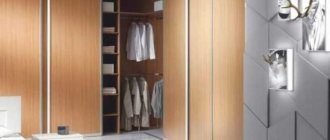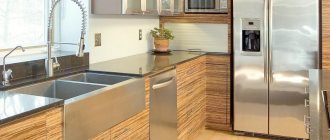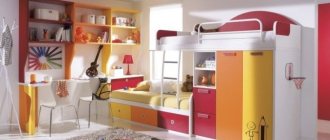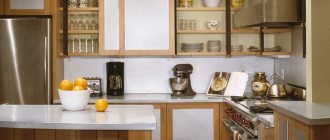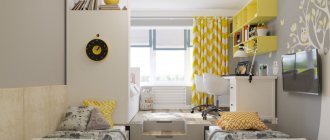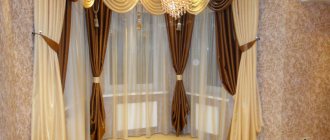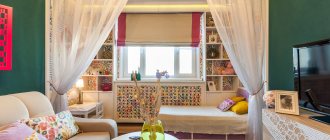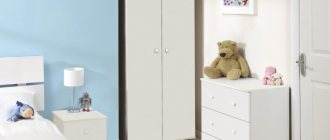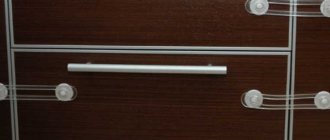0
27618
The decision to install a corner wardrobe in the nursery can definitely be classified as the best, especially if there is a need to save space inside the room. This is also a good style preference, since the variability of corner designs is quite large, and you can always choose the model that will fit most well into the interior.
Requirements for children's furniture
Quality indicators and functional dimensions are set out in GOST 26682-2016, which guides employees of preschool institutions. It does not apply to home furnishings. But, based on the standard, the experience of parents and furniture manufacturers, the main requirements are identified:
- Manufactured from environmentally friendly materials. These include wood and MDF. Chipboard is much inferior. Be sure to check compliance with the quality certificate that the store must provide you with.
- Reliability and strength – resistance to mechanical stress and environmental factors (humidity and temperature). If possible, use a minimum of glass and mirrors, and it is better to do without them.
- Functionality and safety. Dimensions must correspond to the height of the child. This means that with an outstretched arm he can reach the far corner of the top shelf and take any item from without the risk of dropping it. For a tall cabinet, it is recommended to install a pantograph.
How to choose a quality product
Professionals highlight the main signs of quality:
- The attractive appearance of furniture involves the use of bright rich colors or delicate pastels.
- The product must be ergonomic so that it is convenient for the child to place his things and get them out.
- It is worth ordering the most functional design with placement of all the details that are necessary for the life of a child.
Bright wardrobe for the nursery
Differences between a child's closet and an adult's
In fact, a closet is also a closet in Africa. It is simply a storage unit that should perform the required functions for people of any age. Differences may be in the quality of materials, colors, and also in convenience:
- Finishing options - instead of glass and mirrors, use leather, rattan, bamboo, laminate. It is important that these materials do not emit harmful components when interacting with the environment.
- Everything inside should be thought out - focus on spaciousness, do not disdain the use of modern fittings. Place the rods at a certain height depending on the length of the clothing. For dresses and coats, 1400 to 1600 mm are required; for skirts, trousers, blouses, from 900 to 1200 mm will be enough.
- Smoothness and integrity - no sharp corners. It is imperative that the shelves fit tightly.
- Bright colors, colorful photo printing with images from cartoons.
Expert opinion
Svetlana Kolesnikova
Designer
A children's corner wardrobe differs from an adult's in design and functionality. To please the child and develop his desire for order, provide sufficient capacity and ease of access to the compartments. There are models with lighting, additional drawers, baskets.
Corner wardrobes to order
Owners of premises of non-standard dimensions or those wishing to create a unique interior may not buy a ready-made design, but have it made to order. At the same time, all the client’s wishes will be taken into account, the furniture will fully correspond to taste and look original.
Prices for custom-made wardrobes
When preparing to place an order, please note that the price of the model will depend on the following factors:
- Difficulty of manufacturing;
- Production time;
- Material;
- Cabinet size;
- Manufacturer;
- Presence/absence of lighting and fittings.
Custom-made furniture is a great opportunity to show your taste and realize your imagination, but such furniture costs more than standard furniture.
Dimensions of corner wardrobes
The most common corner cabinets are of the following sizes: height 240 cm, length of the upper shelves 135 or 120 cm, depth 60 cm. A hanger bar, coat hooks, shelves (both large and small) can be placed inside. When placing an order, you can specify any , the most non-standard dimensions.
DIY installation
As a rule, each model of a corner wardrobe is supplied with instructions, thanks to which everyone can cope with the installation process.
Kinds
Cabinets vary in material, type of installation, method of opening doors, filling, shape:
- Concave - round the corner, giving the room an unusual look. Used for a small room, since the depth of the box is also insignificant.
- Convex - occupy a larger area compared to other models due to doors curved outward. An analogue is a cabinet with straight doors, which simply removes the angle between two walls.
- Trapezoidal - consist of three compartments of different depths: two lateral and a central one.
- L-shaped - copy the angle. Such models are combined with a chest of drawers, a table and other components.
- With five walls, the bulkiness of the structure explains its spaciousness. But if you have free space and a large number of things, the closet will fit into the room and justify its dimensions.
To accommodate all children's things, it is often necessary to combine models. Several cabinets with different types of doors are assembled into a monolithic structure. Its length may be limited by the length of the room. If you don't need to lock a lot of things in the closet, you can use a corner table. Above it are placed the shelves that come with the kit. There are also compartments under the tabletop
With wall
This is L-shaped cabinet children's furniture. Its advantage over other types is in multiple connections. This creates the appearance of a monolithic structure and allows for rational use of space. Minimum 3 items are connected: a dressing room, a cabinet, open compartments for toys. Combined with bookshelves, a desk and other accessories.
If you need to change the interior, you can remove the modular parts or move the cabinet. The bulkiness of the design is deceptive, as evidenced by customer reviews. Such models free the room from rubble when things are placed correctly. These factors explain the high cost of the set.
With bed
A dressing room combined with a sleeping area makes it possible to free up the room for games and study. Single bunk beds can be placed on the floor or at the top of the room. In the second case, there is a table under the bed. The floor bunk in most models can be moved against the wall in the morning.
More configuration options:
- bunk bed – supplied with ladders;
- a wardrobe with a lower section into which the bed can be removed;
- bed equipped with additional drawers.
The furniture is convenient due to its compactness. Following the wall with the bed there are open shelving and shelves for stationery, books, and toys.
With sliding doors
Install a sliding wardrobe in a children's room if you want to place an ottoman or some other object in front of the doors, but the hinged doors will get in the way. There are models with concave, convex, triangular, and combined facades.
Keep in mind that the depth is reduced in proportion to the number of doors. One sliding panel occupies up to 10 cm of usable area.
Built-in
This type of cabinet is mounted in a wall niche or corner. Advantages over other models:
- saving useful room space;
- sustainability;
- masking wall irregularities;
- solidity;
- the ability to expand functionality with the age of the child due to additional shelves in the upper part.
The cabinet can be limited by the length of the wall or end at the window. The disadvantages include the immobility of the cabinet and the complexity of installation. If you lack experience, it is better to entrust the development of the project and installation of doors to professionals than to do it yourself. Furniture is made to order and costs more than ready-made models.
Classification
There are many different variations of corner cabinets for children's rooms, which differ in the following parameters:
- for its intended purpose (purpose of use);
- form, style decision;
- installation principle;
- materials of creation (the entire structure as a whole and its individual parts - details, decor).
A wide variety allows you to choose the most suitable option that will not disturb the overall atmosphere of the room for children and will allow you to complement it with an interesting and practical design. When choosing a wardrobe for a child, it is better to choose products made from reliable, durable materials that will be easy to clean from various contaminants.
By purpose
When choosing, you should focus on the main purpose of the cabinet. Often the following types are installed in children's rooms:
- A wardrobe is a wardrobe for clothes. Typically, the design consists of 2-3 main compartments, one of which is necessarily responsible for storing summer and winter items on hangers. The rest of the closet contains small shelves and spaces with drawers for clothes, shoes, hats, and various accessories. Furniture of this design is made in a closed form with walls and doors.
- Book storage – necessary for storing various literature or other paraphernalia that a child may need during the learning process. Unlike the dressing room, the book room has an open look with small shelves.
- Universal - this option is suitable for those who have not decided on the main purpose of the product. In addition, the design allows you to independently decide what exactly will be stored in the closet. There is no specific design for this type of product. If necessary, the structure can be equipped with doors behind which clothes and accessories will be stored. The rest of the closet can be left open - textbooks, various literature, and child’s accessories will be stored there.
Usually, when there is a small amount of space, a children's universal corner wardrobe is installed, since it has the greatest practicality and meets the basic needs of the child.
Dressing room
Book
Universal
By shape
Corner cabinets come in many different shapes. There are 5 main designs:
- A five-wall cabinet is the most voluminous form of construction, which is not recommended to be placed in a room with a small amount of free space. Due to its size, such children's furniture has the highest possible functionality and capacity. The wardrobe is suitable for a spacious room with symmetrical walls. The structure itself most often has a swing system or sliding doors.
- Trapezoidal - unlike a conventional triangular cabinet, it has an additional wall, which provides greater capacity and the ability to use shelf space more efficiently. Such structures can be made for various purposes, but usually they house dressing rooms in which summer and winter clothes, as well as outerwear, shoes and various accessories can be stored.
- Triangular is the least spacious design, which is installed in rooms with a small amount of free space. If desired, the furniture can be equipped with sliding, swing or folding doors, and it is also possible to install a model with open shelves, which are necessary for storing books and other devices needed by the child.
- Radius - this design is not very practical due to its non-standard shape, which does not allow you to take full advantage of the large amount of internal space. Such cabinets are most often installed in large rooms. The design is chosen so that it occupies the entire space from floor to ceiling, thereby creating a small separate place where things can be stored. The main disadvantage of such furniture is the high cost, which is determined by the complexity of the design and its installation. Radius cabinets can be concave, curved, or round.
- L-shaped is the most popular type of corner cabinets, which allows you to make the most efficient use of the available internal space. The structure can be equipped to suit any needs and purposes, and almost all types of doors (hinged, sliding, accordion, folding) can be installed on it.
In addition to standard forms, there are also unusual ones: such cabinets, as a rule, are made to order, taking into account all the wishes of the consumer, as well as the key features of the room.
Five-walled
Trapezoidal
Triangular
Radial
L-shaped
By built-in
There are several main types of cabinets:
- Cabinet furniture is often ready-made furniture, which is selected according to the required parameters of the room, after which installation is carried out. Such a cabinet can be easily disassembled or moved to another room.
- Modular is a design that consists of several sections that are not necessarily interconnected. At the same time, it is possible to fulfill any wishes of the owner. Such cabinets are easy to disassemble and transport, but their cost is significantly higher than other furniture.
- Built-in - such a cabinet is installed in a special recess in the wall. For this reason, it may have the largest capacity. Due to the fact that such furniture does not have several walls, the cost is low, but it will be almost impossible to transport the structure.
How to combine furniture for a teenage boy with the interior, tips
In addition to the main varieties, there are combined models that can be combined with beds and desks. This type of furniture is also popular, such as a children's wall. It is quite difficult to find combination models of suitable sizes on the market, so usually such products are made to order, taking into account all the preferences of the owner.
Hull
Modular
Built-in
Based on materials
The following materials are often used in the production of standard cabinet models:
- MDF is made from wood fibers that are treated with synthetic bonding agents. The surface of the material is covered with veneer from any type of wood, but for the same reason such furniture does not have various bright colors. It is environmentally friendly, looks attractive, but is also quite expensive.
- Laminated chipboard is a material that consists of wood chips and also has high resistance to various external influences. If necessary, furniture made from it can be easily cleaned and returned to its original appearance. Laminated chipboard is characterized by low strength and can emit substances harmful to the child’s body.
- Plastic - used quite rarely due to poor resistance to mechanical damage and high temperatures. Despite this, inserts, handles or other elements that are attached to or complement the main structure can be made from it. This material is often used in kindergarten and younger groups for storing things and changing clothes. Round marks with a name or a characteristic design are also left on plastic elements. Plastic is used due to its minimum weight, since children's furniture should be light and safe.
- Wood is the most expensive, but at the same time the most reliable material. However, such cabinets are rarely used in children's rooms due to the fact that they have a small color range of natural tones.
Tips for choosing home furniture for schoolchildren and placement rules
Mirrors, glass, steel, rattan, and decoracrylic can also be used to make facades. The first two materials are the most popular, as they allow you to create a unique furniture design. Lovers of experiments and everything unusual choose rattan options - such facades are easy to paint and can withstand high humidity.
MDF
laminated chipboard
Plastic
Wood
Mirrors
Rattan
Decoracrylic
Dimensions
Before purchasing a ready-made wardrobe, measure the installation location. The dimensions of serial models are based on research by technologists. Minimum height – 1800 mm. Depth – 600 mm. Wall width – 800 and 1200 mm. In most cases, a 450 mm wide partition is installed to limit the width of the shelves.
Low cabinets are suitable for small children. They can be wide and combined with a wall, a pencil case, a bed, a cabinet, a rack, or a chest of drawers. Such furniture is called modular and creates a unified design for a children's room.
The built-in wardrobe is made to order. The measurements are taken by the installation company. The dimensions can be any, depending on your wishes.
Materials
For the manufacture of furniture the following are used:
- Wood (pine, beech, oak, ash) is a natural material that is environmentally friendly. A cabinet made of wood is heavy and expensive. Artistic carvings are used as decoration.
- MDF and chipboard boards are covered with veneer, which makes the boxes look like wood. The lightness and availability of furniture made from this material explains its mass production. There are usually no problems with choosing a model for various layout options.
- Cabinets with laminated surfaces visually increase space by reflecting sunlight. This is an option for processing MDF and chipboard.
Wood has the least amount of harmful substances (formaldehyde). MDF is considered relatively safe. The choice of material according to the degree of toxicity is especially important for children suffering from allergies.
Colors
Coloring a child's room depends on the child's preferences. This is regarded as a manifestation of individuality. But it’s not always possible to ask a child’s opinion, and some children’s ideas cannot all be implemented.
When choosing cabinet color, consider:
- Age. For children under 2 years old, decorate the nursery with desaturated soft tones. These are white, beige, pastel yellow colors combined with blue. At the age of 4, a child develops a need for brightly expressed pure colors - blue, red, yellow. For schoolchildren, include a purple tint, which stimulates brain activity.
- Character and temperament. To moderate the ardor of an overly active child, choose a wardrobe for clothes and things, painted in colors from light blue to pure blue. If your child tends to cry, be left alone, and have little contact with peers, then choose furniture in pink tones with small bright red splashes.
- Range. The optimal colors for decorating children's furniture are delicate light tones of green and blue. Use reds and oranges with extreme caution. Black inclusions are not recommended. The priority is pink, yellow-green tones.
- Gender of the child - use different colors for a girl and a boy.
Pure brown should not dominate the nursery. Give preference to light colors. They promote a good mood and influence the formation of positive thoughts. Psychologists recommend including more blue elements and light shades.
Model selection
Before purchasing, you need to think about the placement of the cabinet, door configuration, content, color scheme, and additional interior items. Installing furniture from the same series develops a child's sense of taste. Check the quality, evaluate the smoothness of surfaces, fastening of fittings, and strength of components. Check the safety of the material using certificates of conformity. There should be no cracks, dents, chips, or foreign odors.
For girl
Pay attention not only to reliability, but also to design. The colors can be whatever the child wishes. But white, pink and beige tones are preferred. Girls need mirrors. When choosing a cabinet with this element, make sure that the glass is tempered and durable. You can diversify the surface with regular or 3D designs with dolls, flowers, and cartoon characters.
For boy
Cabinets are chosen with a predominance of blue. Inclusions of yellow and green colors in the design are at the discretion of the child or parents. Light green or pastel yellow colors are used for the baby. If the child chooses the palette himself, then you can trust his opinion. Drawings and photo prints of his favorite characters and cars will delight the boy.
For two children of different genders
Psychologists recommend dividing the room with a partition and selecting separate furniture. If this is not possible, then choose a cabinet without patterns or illustrations. It can be painted any color the children wish. If the choice lies with them, then it is important that they agree among themselves and come to a consensus. Consider the age difference. One child can go to kindergarten, the other to school. Then it is better not to place toys and textbooks in a shared closet. For two children, a corner wardrobe is suitable, which includes 2 independent parts.
Design of corner wardrobes
Corner wardrobes inside
The interior space of the cabinet can be divided into three zones: the upper part is a large shelf for storing rarely used items, the middle zone is the main part where shelves, hooks, rods and a lower shelf used for shoes are located. Some models are equipped with small baskets in which you can store small items, drawers, and an iron holder.
Exterior finishing
There are several types of external design of such furniture:
- mirror
- radius
- with photo printing
Both the internal and external design of corner wardrobes is characterized by a wide variety.
Popular models
Parents can be creative and create their own wardrobe designs for their children. Custom-made furniture is made in all regions of Russia.
Modular bedroom components can be purchased separately, depending on the size of the children's room and budget.
The table shows 5 popular cabinet models and ready-made solutions for rooms:
| Description | Photo | Approximate price, rub. |
| Rainbow is a corner wardrobe as part of a children's design project. Made of white chipboard with a blue border. A universal wardrobe is used for clothes, books, sports equipment and other things. | 11265 | |
| Rico is a series of corner cabinets with 3 types of handle finishes: coral, wenge, aqua. The models fit into any room due to their simplicity, so it is not necessary to buy all the furniture in the series. Suitable for any child and two children of different sexes. | 13584 | |
| Lego is a ready-made room in the form of a constructor. Instead of handles, there are recesses that make it easier for the child to open the doors. There are 21 colors to choose from in different combinations. | 27430 | |
| Boguslav's Comfort-S M3 is a series of furniture for decorating in the style of a sailor's room. Suitable for a teenager. | 8590 | |
| Children's caramel KA-09 – a bed, hanging boxes and pencil cases are attached to the corner cabinet. There are options for boys and girls. | 7993 |
Features of a corner wardrobe
Differences from a regular wardrobe
The most significant difference is already contained in the name - the corner version is placed in the corner of the room, which allows for space saving, while a regular wardrobe is located along the wall. In addition, they also differ in appearance: if ordinary models are, as a rule, rectangular in shape, then corner ones are much more diverse: these are rectangular, trapezoidal, and five-walled formats.
Advantages of a corner wardrobe
- Compact: this design is ideal for small spaces and will save space;
- Spaciousness: despite being economical, such models are quite deep, equipped with several internal shelves and allow you to store a large number of things;
- This furniture is at the peak of popularity, so modern furniture factories offer a wide range of models and color variations, which is why choosing a model to suit your individual taste will not be difficult;
- Versatility: such cabinets are perfect for any room in the apartment, be it a children's room, a living room, or a bedroom.
Disadvantages of a corner wardrobe
- Such models are usually placed in a corner, so when purchasing, you may need to rearrange the room;
- The sliding wardrobe is equipped with a special mechanism, rails for moving doors, which takes up some space in the internal space (about 10 cm);
- The mechanism requires care; first of all, it should be kept clean.
As you can see, the disadvantages are insignificant, there are fewer of them than advantages, and this is precisely what explains the popularity of such furniture among Russian consumers.
Care
Cleaning the closet is not very demanding. But there are some points to consider. The use of metal brushes and abrasives is prohibited. Use microfiber cloths for dusting and washing. No one will forbid you to use sponges at home. But they are recognized by the SES as an unprocessable and dangerous material, so it is better to do without them in the nursery.
Clean models with a mirror using special glass cleaners with antibacterial, antistatic, and hypoallergenic effects. Stains from surfaces can be removed with soapy water. When installing a cabinet with sliding doors, you need to monitor the condition of the bottom rail. It is most often sprayed.
The instructions for the furniture describe its susceptibility to various factors. Some models do not tolerate direct exposure to sunlight or are damaged by moisture. You need to think about placement and clean it according to the instructions. The optimal humidity for normal operation is 55-75%, temperature – from 5 to 45C.
